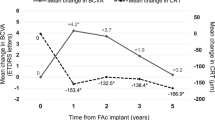Abstract
Fluocinolone acetonide intravitreal implant (Iluvien®) is an injectable, non-erodible, corticosteroid implant that is approved in several European countries for the treatment of chronic diabetic macular oedema (DMO). In analyses of two multinational trials in patients with DMO previously treated with macular laser photocoagulation, fluocinolone acetonide intravitreal implant 0.2 μg/day was significantly more efficacious than sham injection in improving visual acuity. At 24 months post injection, 29 % of fluocinolone acetonide intravitreal implant 0.2 μg/day recipients had an improvement in the best-corrected visual acuity (BCVA) letter score of ≥15 compared with 16 % in the sham injection group (p = 0.002) [primary endpoint]. Treatment benefit was most evident in the subgroup of patients whose duration of DMO was ≥3 years. In this subgroup at 36 months, 34 % of fluocinolone acetonide intravitreal implant 0.2 μg/day recipients had an increase in the BCVA score of ≥15, compared with 13 % of sham injection recipients (p < 0.001). Fluocinolone acetonide intravitreal implant recipients also had generally greater benefits than sham injection recipients on secondary endpoints. In patients who were phakic in the study eye at baseline, cataracts occurred in 82 % of fluocinolone acetonide intravitreal implant 0.2 μg/day recipients and 51 % of sham injection recipients. Overall, 37 % and 12 % of patients in the fluocinolone acetonide intravitreal implant and sham injection groups developed raised intraocular pressure (IOP), which was generally controlled with IOP-lowering drugs.



Similar content being viewed by others
References
Blumenkranz MS. Optimal current and future treatments for diabetic macular oedema. Eye. 2010;24(3):428–34.
Yau JWY, Rogers SL, Kawasaki R, et al. Global prevalence and major risk factors of diabetic retinopathy. Diabetes Care. 2012;35(3):556–64.
Bhagat N, Grigorian RA, Tutela A, et al. Diabetic macular edema: pathogenesis and treatment. Surv Ophthalmol. 2009;54(1):1–32.
Eljarrat-Binstock E, Pe’er J, Domb AJ. New techniques for drug delivery to the posterior eye segment. Pharm Res. 2010;27(4):530–43.
Bausch & Lomb Inc. Retisert (fluocinolone acetonide intravitreal implant) 0.59 mg for intravitreal use: US prescribing information; 2011. http://www.accessdata.fda.gov/drugsatfda_docs/label/2011/021737s019.pdf. Accessed 21 November 2012.
Pearson PA, Cornstock TL, Ip M, et al. Fluocinolone acetonide intravitreal implant for diabetic macular edema: a 3-year multicenter, randomized, controlled trial. Ophthalmology. 2011;118(8):1580–7.
Medicine and Healthcare products Regulatory Agency. Iluvien 190 micrograms intravitreal implant in applicator: summary of product characteristics; 2012. http://www.mhra.gov.uk/home/groups/spcpil/documents/spcpil/con1342494701591.pdf. Accessed 19 November 2012.
Grover D, Li TJ, Chong CCW. Intravitreal steroids for macular edema in diabetes. Cochrane Database Syst Rev. 2008(1):CD005656.
Jobling AI, Augusteyn RC. What causes steroid cataracts? A review of steroid-induced posterior subcapsular cataracts. Clin Exp Optom. 2002;85(2):61–75.
Kersey JP, Broadway DC. Corticosteroid-induced glaucoma: a review of the literature. Eye. 2006;20:407–16.
Campochiaro PA, Nguyen QD, Hafiz G, et al. Aqueous levels of fluocinolone acetonide after administration of fluocinolone acetonide inserts or fluocinolone acetonide implants. Opthalmology. 2012;. doi:10.1016/j.optha.2012.09.014.
Campochiaro PA, Brown DM, Pearson A, et al. Long-term benefit of sustained-delivery fluocinolone acetonide vitreous inserts for diabetic macular edema. Ophthalmology. 2011;118(4):626–35.e2.
Campochiaro PA, Brown DM, Pearson A, et al. Sustained delivery fluocinolone acetonide vitreous inserts provide benefit for at least 3 years in patients with diabetic macular edema. Ophthalmology. 2012;119(10):2125–32.
Alimera Sciences Inc. Fluocinolone acetonide in diabetic macular edema (FAME) extension study. 2012. http://clinicaltrials.gov/ct2/results?term=NCT01304706. Accessed 19 November 2012.
Disclosure
The preparation of this review was not supported by any external funding. During the peer review process, the manufacturer was offered an opportunity to comment on this article. Changes resulting from any comments received were made by the author on the basis of scientific and editorial merit.
Author information
Authors and Affiliations
Corresponding author
Additional information
The manuscript was reviewed by: R.G. Fiscella, Department of Pharmacy Practice, University of Illinois at Chicago, Chicago, IL, USA; T.L. Levien, Pharmacotherapy Department, Washington State University Spokane, Spokane, WA, USA; J.A. Micieli, Department of Ophthalmology and Vision Science, University of Toronto, Toronto, ON, Canada.
Rights and permissions
About this article
Cite this article
Sanford, M. Fluocinolone Acetonide Intravitreal Implant (Iluvien®). Drugs 73, 187–193 (2013). https://doi.org/10.1007/s40265-013-0010-x
Published:
Issue Date:
DOI: https://doi.org/10.1007/s40265-013-0010-x




